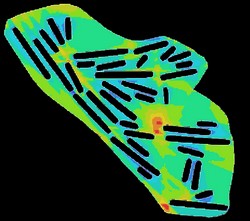The Archaeology Centre University of Toronto
My dissertation research begins with the following question: “what was the changing role of the built environment in the process of sedentarization that took place among the Iroquoian-speaking peoples of Northeastern North America, ca. AD 800 – 1450?”
In order to address this question, I have implemented a broad-scale analysis of the changing spatial configuration of settlements in what is today south-central Ontario, Canada, for the period of interest. This project involves the digitization in ArcGIS of over 20 complete Iroquoian village plans dating between AD 800 and 1450, and the subsequent analysis of spatial organization both within houses, and of the global organization of houses within settlements.
Analysis of settlement organization follows a number of different methodologies, including traditional organizational measures based on spatial clustering (e.g. K-means), space syntax approaches (axial analysis and justified access graphs), explicitly visual methods (isovist and visibility graph analysis), and distributional approaches influenced by Whallon’s unconstrained clustering method.
The object of these analyses is to consider the manner in which built environments both conditioned, and were conditioned by, social interactions at various scales in a context of increasingly sedentary, nucleated village life.
Distribution of Visual Control at the Draper Village ca. 1450 AD Ontario, Canada
Interior of Reconstructed Iroquoian Longhouse at the Lawson Site, Canada




